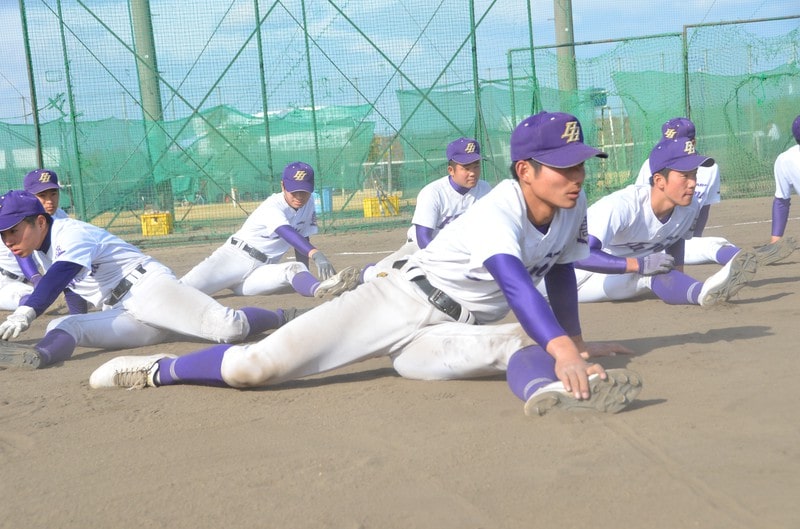
Flexibility is a very important factor in baseball.
Proper flexibility is essential for athletes to perform at their best and prevent injury.
This article explores the importance of flexibility and how to improve it.
This book provides a comprehensive introduction to specific training menus for improving flexibility, daily care methods, the latest research findings, and more, providing guidelines for athletes to effectively improve their flexibility.
目次
- 1 The importance of flexibility in baseball
- 2 Effective flexibility training methods
- 3 Stretching menu for baseball players
- 4 Daily care to improve flexibility
- 5 The relationship between baseball performance and flexibility
- 6 How to assess and monitor flexibility
- 7 The latest in flexibility training and research
The importance of flexibility in baseball
For baseball players, flexibility is a very important factor in improving the quality of play and preventing injuries.
Increasing your flexibility allows you to have a greater range of motion and perform a wider range of movements more efficiently.
Here we take a closer look at how flexibility contributes to improved performance and the benefits it has in terms of injury prevention.
The role of flexibility in improving performance
Flexibility is a vital element for baseball players to perform at their best.
The benefits of increased flexibility include:
-
Improved movement efficiency : High flexibility allows muscles and joints to move more freely, improving performance in pitching and batting. For example, a pitcher’s smooth arm swing increases the ball’s speed and improves control. Also, a batter’s increased flexibility allows him to swing with a wider range of motion.
-
Power generation : Flexible muscles are the foundation for maximum power generation. Stiff muscles make it difficult to fully transmit power during movement, but flexible muscles allow for more efficient power transmission. This allows pitchers to throw faster and batters to hit the ball harder.
-
Improved Reaction Speed : Flexibility allows for quicker movement, which is especially important on defense, as it allows for faster reaction times to batted balls and greater defensive range. Increasing flexibility will allow outfielders to make better catches of fly balls, while infielders will be able to move quickly to field ground balls.
-
Improved endurance : Increasing flexibility reduces muscle fatigue and improves endurance. Flexible muscles help maintain performance by preventing fatigue even during long periods of play. This allows you to continue playing at a high level even at the end of a match.
The effect of flexibility on injury prevention
Flexibility also plays a big role in preventing injuries.
The effects are as follows:
-
Reduced strain on muscles and joints : Greater flexibility reduces strain on muscles and joints. Stiff muscles are more susceptible to stress and can cause injury, while flexible muscles are better able to absorb shock. This helps prevent muscle sprains and joint damage.
-
Improved balance : High flexibility improves your body’s balance. Good balance helps prevent unexpected falls and awkward postures while playing, reducing the risk of injury. It is especially important to maintain your body balance when pitching or batting.
-
Improved blood flow to muscles : Increasing flexibility improves blood flow to muscles. Better blood flow improves the delivery of oxygen and nutrients to muscles, improving recovery. This helps you recover faster from fatigue and reduces the risk of injury.
-
Promotes recovery : High flexibility helps muscles and joints recover faster. Maintaining flexibility helps relieve muscle tension after a match or training session and makes it easier to flush out fatigue substances. This improves performance the next day and helps prevent injuries.
For these reasons, flexibility is extremely important for baseball players.
Proper flexibility can improve performance and prevent injury.
Next, let’s look at some specific flexibility training methods.

Effective flexibility training methods
To improve your flexibility, it is important to choose the right stretching techniques and incorporate them into your training.
Here we will explain in detail the differences between dynamic and static stretching, as well as the importance of warming up and cooling down.
The difference between dynamic and static stretching
There are two main types of stretching: dynamic stretching and static stretching.
Let’s take a look at the characteristics and effects of each.
-
Dynamic stretching : Dynamic stretching is a type of stretching that involves dynamic movements. It aims to increase flexibility and range of motion while moving muscles and joints. The main characteristics of dynamic stretching are as follows:
- Movement : Stretching while moving helps warm up the muscles and increases blood flow, which in turn increases muscle temperature and improves flexibility.
- GREAT WARM-UP : Performed before exercise, it primes muscles and joints, reducing the risk of injury. Dynamic stretching is widely recommended as a pre-exercise warm-up.
- Example : Leg swings, arm circles, and lounge walks are some common dynamic stretches that can effectively improve your overall flexibility.
-
Static stretching : Static stretching is a method of stretching muscles in a static state. The purpose is to stretch muscles while maintaining a certain posture and increase flexibility. The main characteristics of static stretching are as follows:
- Static postures : Holding the muscles in a certain position and slowly stretching them helps release tension and relax the muscles.
- GREAT FOR COOLING DOWN : Static stretching after exercise promotes muscle recovery and reduces fatigue. Static stretching is commonly used as part of a cool down.
- Examples : Hamstring stretches, calf stretches, and shoulder blade stretches are some common static stretches that can be used to effectively stretch specific muscle groups.
The importance of warming up and cooling down
Warming up and cooling down are very important for effective flexibility training.
The purpose and effect of each will be explained in detail below.
-
The Importance of Warming Up : Warming up is an important step to prepare your body before exercise. A proper warm-up will increase the temperature of your muscles and joints and help prevent injury during exercise.
- Increased blood flow : Warming up increases blood flow to your muscles, supplying them with oxygen and nutrients, which makes them warmer and more flexible.
- Increase your heart rate : Warming up helps to gradually increase your heart rate, which helps your heart and circulatory system adapt to the exercise.
- Mental preparation : Warming up helps you to be more mentally prepared for the exercise and improves your performance.
-
The Importance of Cooling Down : Cooling down is an important step after exercise to relax your body and promote recovery. A proper cool down can help release muscle tension and reduce fatigue.
- Muscle recovery : Cooling down helps release muscle tension and aids recovery, especially if you incorporate static stretching.
- Normalize blood flow : Cooling down after exercise helps normalize blood flow and flush out fatigue substances that have accumulated in the muscles.
- Mental relaxation : Cooling down also relaxes you mentally and prepares you for the next round of exercise.
As mentioned above, understanding the difference between dynamic and static stretching, the importance of warming up and cooling down, and incorporating appropriate flexibility training will lead to improved performance and prevention of injuries.
Next, let’s take a look at some specific stretching exercises.

Flexibility is very important for a baseball player.
Here we will introduce a specific stretching routine to maintain balance between the upper and lower body, and the entire body.
These programs are designed to increase flexibility, prevent injuries and improve performance.
Stretching to improve upper body flexibility
Upper body flexibility is especially important for pitchers and hitters.
Increasing the flexibility of your shoulders and arms will enable smoother throws and swings.
-
Shoulder Blade Stretch :
- How to do it : Place your hands behind your back and bring your arms up, squeezing your shoulder blades together. Hold this position for 30 seconds to a minute.
- Benefits : Stretches the muscles around the shoulder blades and increases the range of motion of the shoulders.
-
Arm Circle :
- HOW TO DO IT : Raise your arms to shoulder height and rotate them in small circles, back and forth for 30 seconds each.
- Benefits : Dynamically stretches the muscles around the shoulders and improves blood flow.
-
Chest Stretch :
- How to do it : Place one arm on the wall and rotate your body to the other side. Hold this position for 30 seconds, then repeat on the other side.
- Benefits : Stretches the chest muscles and increases flexibility in the shoulders and chest.
Stretching to improve lower body flexibility
Flexibility in the lower body is important for defense, base running, and stepping forward when pitching.
It is especially important to increase flexibility in the hip joints and hamstrings.
-
Hamstring Stretch :
- How to do it : Lie on your back and lift one leg up towards the ceiling. Use a towel or strap to pull the leg up and hold for 30 seconds. Repeat on the other side.
- Benefits : Effectively stretches the hamstrings, improving running ability and throwing stability.
-
Hip Stretch :
- How to do it : Step forward with one leg and step back with the other, bending your knee until your front knee is at a right angle and hold for 30 seconds. Repeat on the other side.
- Benefits : Increases hip flexibility and range of motion.
-
Calf Stretch :
- How to : Place your hands against a wall and step one leg back, pressing your heel into the ground. Hold for 30 seconds, then repeat on the other side.
- Benefits : Stretches the calf muscles, improving running power and stamina.
Stretching to maintain balance throughout the body
Maintaining a balanced body helps prevent injury and improves performance.
Stretching the core is especially effective.
-
Cat-Cow Pose :
- How to : Come to all fours and alternate between arching your back in Cat Pose and arching your back in Cow Pose. Hold each for five seconds and perform five to 10 repetitions.
- Benefits : Flexes the back and abdominal muscles and improves core balance.
-
Plank :
- How to do it : Get into a push-up position with your elbows on the ground and your body straight. Hold this position for 30 seconds to a minute.
- Benefits : Increases core strength and flexibility, improving overall body balance.
-
Spine Twist :
- How to do it : Sit with your legs extended and one knee bent, resting your elbow on the other knee. Rotate your body to lengthen your spine. Hold for 30 seconds, then repeat on the other side.
- Benefits : Increases flexibility of the spine and maintains balance throughout the body.
Incorporating these stretches into your daily training can effectively improve your flexibility as a baseball player.
Next, let’s look at daily care to improve your flexibility.

Daily care to improve flexibility
Daily care is essential to improve flexibility.
You can improve your flexibility by developing an effective stretching routine, understanding the importance of nutrition and hydration, and incorporating them into your daily life.
Here we will explain in detail how to create a daily stretching routine and the importance of nutrition and hydration.
How to create a daily stretching routine
To improve your flexibility, it’s important to develop a daily stretching routine.
Follow these tips to create an effective routine:
-
Clarify your goal : Clarify the area and purpose for which you want to improve your flexibility. For example, set a specific goal, such as increasing the range of motion for pitching or making your batting swing smoother.
-
Choose your stretches : Include a balance of dynamic and static stretches. Perform dynamic stretches before exercise to warm up muscles and increase range of motion, and static stretches after exercise to release muscle tension and improve flexibility.
-
Warm up : Before you start stretching, warm up your body by doing some light aerobic exercise. Warming up will make your muscles more flexible and enhance the effect of your stretches. We recommend 5 to 10 minutes of exercise, such as jogging or jumping rope.
-
Stretch your whole body evenly : It is important to stretch your whole body evenly, not just specific parts of your body. In particular, stretching the muscles of your upper body, lower body, and core evenly can improve your overall flexibility.
-
Take your time : Take your time when stretching. Aim for 30 seconds to a minute for each stretch, and stretch as slowly as you can. Rushing can cause muscle injury.
-
Do it every day : The key to improving your flexibility is to do it every day. By doing a little stretching every day, within your limits, your flexibility will gradually improve.
The Importance of Nutrition and Hydration
Proper nutrition and hydration are essential to improving your flexibility.
Pay attention to the following points and incorporate them into your daily diet.
-
Protein intake : Protein is important for muscle repair and growth. Getting enough protein is also necessary to improve flexibility. Include good quality protein sources such as chicken, fish and soy products in every meal.
-
Vitamin and mineral intake : Vitamins and minerals are necessary for muscle function and health. Vitamins C and E, calcium, and magnesium in particular help keep muscles flexible. Eat fruits, vegetables, and nuts.
-
Hydration : Proper hydration is important to maintain muscle flexibility. Dehydration can lead to muscle stiffness and increased risk of injury. Be sure to drink plenty of fluids during and after exercise. Sports drinks containing electrolytes are also effective, especially in hot weather or when exercising a lot.
-
Eat a balanced diet : An unbalanced diet can have a negative impact on muscle health. It’s important to eat a balanced diet that includes carbohydrates, protein and fats, and has a balanced overall nutritional profile. Include a variety of foods, such as whole grains, vegetables, fruits, fish and nuts.
-
Use appropriate supplements : If it is difficult to get the necessary nutrients through diet alone, consider using supplements. In particular, nutrients related to muscle flexibility, such as vitamin D and omega-3 fatty acids, can be supplemented with supplements. However, care should be taken not to take too much.
By incorporating this into your daily routine, you can effectively improve your flexibility, leading to improved performance and injury prevention.
Next, let’s take a closer look at the relationship between baseball performance and flexibility.

The relationship between baseball performance and flexibility
Flexibility has a huge impact on a baseball player’s performance, especially when it comes to pitching and batting.
Here we take a closer look at the impact of flexibility on pitching and hitting.
The effect of flexibility on pitching
The throwing motion is extremely complex, with many muscles and joints moving in tandem.
Players with high flexibility can utilize this coordination more efficiently and improve their pitching performance.
-
Increased Range of Motion : Greater flexibility in the shoulders, elbows and hips increases the pitcher’s range of motion, allowing the pitcher to swing the ball further, resulting in greater velocity and control. Flexible shoulder joints also increase stride length and optimize the release point of the pitch.
-
Efficient power transfer : Flexible muscles and joints allow for more efficient power transfer throughout the body. In pitching, in particular, the force from the lower body must be transferred to the upper body and then to the arms and fingertips. High flexibility allows for this transfer to occur more smoothly, allowing for faster, more controlled throws.
-
Preventing injuries : Having good flexibility reduces stress on the shoulders and elbows, lowering the risk of injury. Pitchers are particularly susceptible to shoulder and elbow injuries, so maintaining the flexibility of these joints is important. Flexible muscles can better withstand sudden movements and excessive stress, helping to maintain long-term health.
-
Reduced fatigue : Highly flexible muscles are less prone to fatigue and have improved endurance. Pitchers throw many balls in a game, so having flexible muscles allows them to pitch longer innings. Reducing fatigue also helps maintain pitching form and contributes to stabilizing performance.
The effect of flexibility on hitting
Flexibility is also extremely important in striking.
Flexibility plays a major role in improving your swing and hitting power.
-
Smooth swing : Players with high flexibility have smoother and more efficient swings. In particular, high flexibility in the hips, shoulders, and arms allows for smoother swing of the bat and improves the accuracy of hitting the ball. A smoother swing also leads to an improved meet rate.
-
Improved swing speed : Flexible muscles and joints also contribute to improved swing speed. In particular, high flexibility in the shoulders and chest increases the bat head speed and increases the distance of the hit ball. A faster swing speed allows you to hit the ball with more force, increasing the probability of a hit or a home run.
-
Batting stability : A player with high flexibility can swing while maintaining balance. If the trunk and legs are flexible, the axis of the body will be stable during the swing, and a stable batting form can be maintained. This will improve the contact rate and lead to an improvement in batting average.
-
Improved reaction time : A player with high flexibility can react faster to pitches. In particular, players with high flexibility in the hips and knees can move their body quickly to match the pitch and start swinging at the right time. This makes it easier to respond to curveballs and fastballs.
-
Prevention of injuries : Increasing flexibility can also prevent injuries to the hips and knees, which are likely to occur during hitting. Flexible muscles and joints are more likely to withstand sudden movements and loads, reducing the risk of injury during hitting. Injury prevention is especially important for maintaining stable performance throughout a long season.
Flexibility is an important factor that directly affects all aspects of baseball performance, including pitching and hitting.
By incorporating proper stretching and care into your daily routine, you can improve your flexibility, enhance your performance, and prevent injury.
Now let’s take a closer look at how to assess and monitor flexibility.

How to assess and monitor flexibility
Improving flexibility is important for baseball players, but regular evaluation and monitoring is required to realize and sustain the benefits.
Here we explain in detail how to self-assess and have your flexibility assessed by an expert.
Self-assessment and checkpoints
Self-assessment is important so you can check in with yourself about the state of your flexibility and make adjustments to your training if necessary.
Use the following checklist to help you self-assess your flexibility:
-
Forward bending test :
- HOW TO DO IT : Stand with your feet shoulder-width apart and bend forward without bending your knees, placing your hands on the floor. See how far you can reach.
- Look for : If your hands can reach or are close to the floor, you have good flexibility in your hamstrings and lower back. If not, you need to do some flexibility stretches in those areas.
-
Shoulder blade flexibility :
- How to do it : Place one arm over your back and the other under your back, clasping your hands together behind your back. You can also do it the other way around.
- Checkpoint : If your hands are touching or close together, you have good flexibility around your shoulder blades. If they are not touching, focus on stretching that area.
-
Spine Twist :
- How to do it : Sit upright in a chair, place one hand on the opposite knee, and rotate your body in the opposite direction.
- Checkpoint : If you can rotate your hips smoothly and without pain or discomfort, your spine and hips have good flexibility. If you have difficulty rotating, you need to stretch to increase flexibility in that area.
-
Calf Raise Test :
- How to do it : Stand with your feet shoulder-width apart and raise your heels onto your toes. Hold this position for a few seconds.
- Tips to check : If you can maintain balance easily and there is no strain in your calves, then your calf flexibility is good. If you have difficulty maintaining balance, you need to stretch to increase flexibility in that area.
-
Hip flexibility :
- How to do it : Sit on one knee and extend your other leg in front of you, then lean forward. Repeat on the other side.
- Tip : If you don’t feel any pain or discomfort when bending forward, your hip flexibility is good. If you do feel pain, you need to do some stretches to improve the flexibility of that area.
Expert flexibility assessment methodology
To assess flexibility more accurately, it may be a good idea to seek the help of an expert.
Below are the main methods of flexibility assessment used by experts:
-
Range of motion test :
- How : A physical therapist or trainer will measure your range of motion, for example, evaluating the movement of each joint, such as external and internal rotation of the shoulder, or flexion and extension of the hip.
- Effect : The flexibility of each joint is accurately measured, and you will receive specific instructions on the necessary stretches and training.
-
Muscle Flexibility Test :
- How it works : Your physical therapist or trainer will test the flexibility of specific muscle groups. For example, they will evaluate major muscle groups such as the hamstrings, quadriceps, and calves.
- Benefits : You can get a detailed understanding of your muscle flexibility and pinpoint areas of inflexibility, allowing you to create an effective stretching program.
-
Behavioral Analysis :
- Methodology : Sports medicine experts use video analysis of athletes’ movements to assess the impact of flexibility, for example analysing pitching and batting movements and examining the range of motion of joints and muscle activity in detail.
- Effect : You will be able to identify which areas of your movement are lacking in flexibility and receive specific suggestions for improvement.
-
Physical Assessment :
- How we do it : We evaluate your overall flexibility, strength and balance through a comprehensive physical assessment, including posture evaluation and strength and balance testing.
- Benefits : Evaluates your overall flexibility and provides the basis for designing a balanced training program.
By utilizing these assessment methods, you can accurately understand the state of your flexibility and provide appropriate training and care.
Let’s take a closer look at the latest in flexibility training and research.

The latest in flexibility training and research
Flexibility training is constantly evolving thanks to scientific research and technological advances.
Here we will take a closer look at flexibility training from a scientific perspective, as well as the latest training methods and their effectiveness.
The science behind flexibility training
Flexibility training is important to maximize the range of motion of your muscles and joints.
From a scientific point of view, the following points are considered important in flexibility training:
-
Muscle elasticity and flexibility : Muscles are elastic and can stretch within a certain range. Flexibility training increases muscle elasticity and flexibility, allowing for a greater range of motion. Stretching both muscle fibers and fascia is effective.
-
Nervous system adaptation : Flexibility is not just about muscles, but also about nervous system adaptation. Stretching improves flexibility by controlling the nervous system’s reflexes and suppressing the muscle stretch reflex. Regular stretching can promote nervous system adaptation and increase flexibility.
-
Improves Blood Flow to Muscles : Scientific studies have shown that stretching improves blood flow to muscles, increasing the supply of oxygen and nutrients. This helps muscles recover faster and improves flexibility. Proper blood flow is important for muscle health.
-
Role of hormones : Hormones such as growth hormone and estrogen affect flexibility. In particular, women tend to have more flexible muscles due to the influence of estrogen. Moderate exercise and stretching are recommended to promote the secretion of these hormones.
The latest training methods and their effectiveness
Modern flexibility training methods are developed based on scientific research.
Below we will introduce some of the latest training methods and their effects.
-
Fascia Release :
- How to do it : Fascia Release is a stretching method that targets the fascia. It uses a foam roller or massage ball to release the fascia and increase muscle flexibility.
- Benefits : Reduces myofascial tension and increases muscle range of motion, which improves muscle performance and reduces the risk of injury.
-
PNF Stretching :
- How to do it : Proprioceptive Neuromuscular Facilitation (PNF) stretching is a technique that increases flexibility by alternating muscle contraction and relaxation. It is typically done in pairs with a trainer.
- Benefits : Effectively relieves muscle tension and maximizes range of motion. Particularly effective for athletes, it can improve flexibility in a short period of time.
-
Yoga and Pilates :
- How to do it : Yoga and Pilates are exercises that increase flexibility throughout the body, combined with breathing techniques to release muscle tension and improve balance.
- Benefits : Improves muscle flexibility, core stability and balance. Particularly effective for sustained improvement of flexibility.
-
Active Isolated Stretching (AIS) :
- How it works : AIS is a method to increase flexibility by repeatedly stretching specific muscles for short periods of time. Stretching is done for short intervals of about 2 seconds, encouraging muscle contraction.
- Benefits : Effectively improves muscle flexibility and reduces muscle fatigue. Particularly popular among athletes, it contributes to improved performance.
-
Dynamic Stretching :
- How to do it : Dynamic stretching is a way to lengthen muscles while moving. It can be used as a warm-up to warm up muscles and improve flexibility.
- Benefits : Increases muscle temperature and improves athletic performance. Decreases risk of injury when used before exercise.
Modern flexibility training methods are based on scientific research and have been proven to be effective.
By incorporating these techniques, you can effectively improve your flexibility, which can help improve performance and prevent injury.
Regular training and evaluation is key to improving flexibility.




